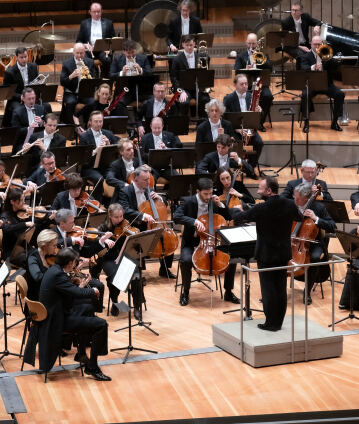Kirill Petrenko conducts Bartók’s “The Wooden Prince”

Only when someone overcomes his pride does he encounter true love: that is the message of Béla Bartók’s The Wooden Prince. This exquisitely orchestrated dance pantomime, which alternates between sensuousness and realism, helped the composer achieve his breakthrough. Kirill Petrenko has also programmed another work that was a milestone in its composer’s career: Henri Dutilleux’s First Symphony.
Henri Dutilleux left behind only a few selected works. He worked on them with great attention to detail until he was able to allay his harsh self-criticism. Dutilleux never followed a school or a trend, but stylistically and confidently played with compositional techniques and aesthetic movements. In 1951, he received an important European radio prize for his First Symphony – and suddenly found fame. His Symphony No. 1 conjures up a hypnotic sound panorama full of sophisticated rhythms. The soundscapes float like flowing watercolours, the double basses dab the first drops onto the canvas at the beginning – eventually the colours shimmer, collide, merge and form ever new variations.
In 1914, Belá Bartók took inspiration from a fairy tale by Béla Balázs, who had already written the libretto for his opera Bluebeard’s Castle. The seven-part ballet tells the story of a puppet that a prince has carved in his image in order to win over a princess. The block of wood awakens and proves to be a demonic, dancing competitor for the princess’s heart. Bartók composed a fast-paced musical tale with incisive rhythms and folk melodies, which he had painstakingly collected and notated while travelling several years earlier. The music depicting the individual stages of the couple’s journey is at times raw, tender, sometimes grotesque, and at other times voluptuous. Bartók’s path to the premiere of the work was a rocky one and, like the story of the wood-carved prince, had a happy ending – with Bartók’s unexpected breakthrough on the world stage.
© 2024 Berlin Phil Media GmbH
Related interviews
Artists
Our recommendations
- 2023 Europakonzert from Barcelona with Kirill Petrenko
- Kirill Petrenko conducts Brahms, Zimmermann and Dusapin
- Kirill Petrenko conducts Strauss, Shostakovich and Norman
- Kirill Petrenko and Christian Gerhaher
- Season opening 2024: Kirill Petrenko conducts Bruckner’s Fifth
- Kirill Petrenko conducts Dallapiccola’s “The Prisoner”